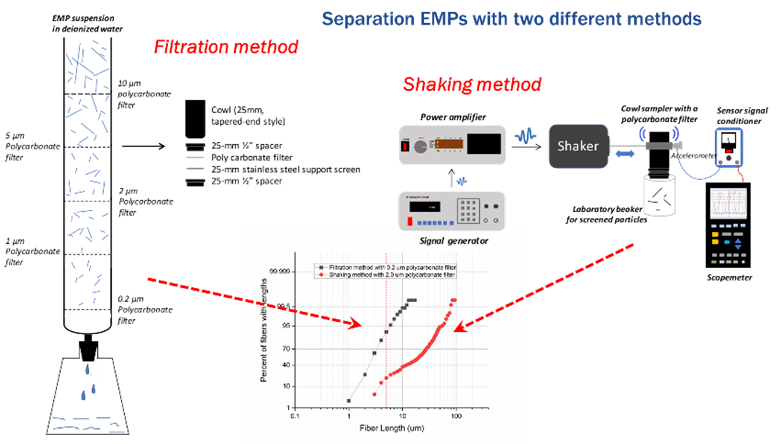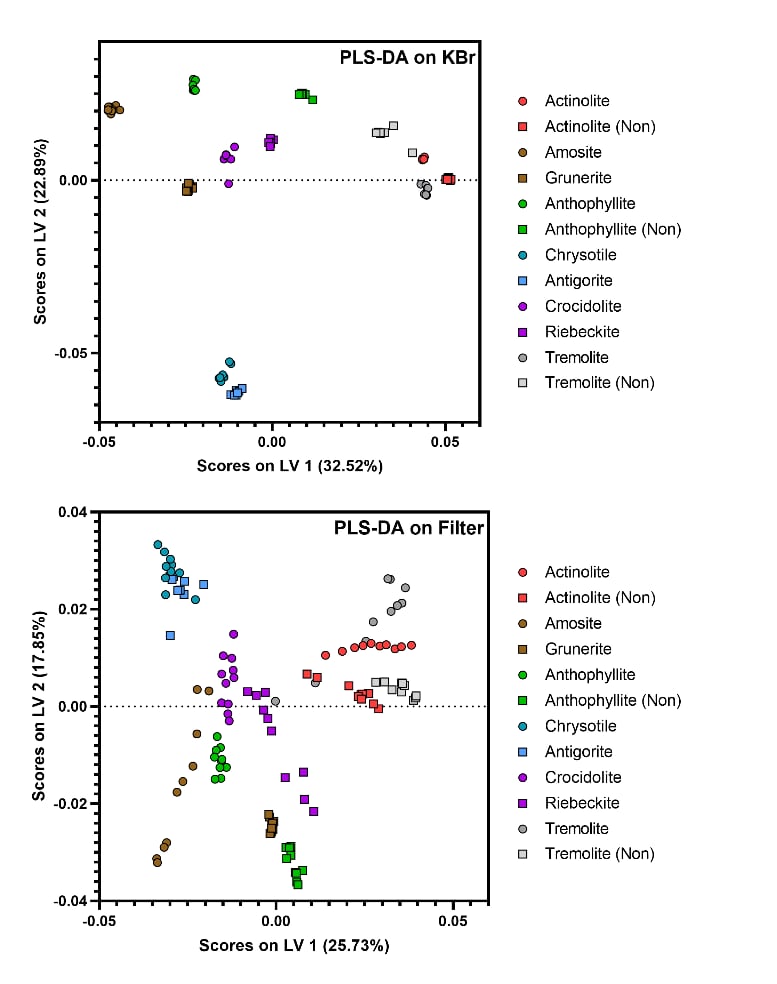Mining Project: Understanding Elongate Mineral Particle Exposure in Mining
| Principal Investigator |
|
|---|---|
| Start Date | 10/1/2018 |
| End Date | 9/30/2023 |
| Objective |
During the mining and processing of some mineral commodities and other rock types, the potential exists to produce respirable dust containing naturally occurring elongate mineral particles (EMPs), including both asbestos and/or non-asbestos fibers. EMPs have been documented to cause lung cancer and mesothelioma in humans, in addition to fibrotic lung disease, with some estimating up to 76,700 EMP-caused lung cancer deaths between 1980 and 2009. While NIOSH estimates that 44,000 mine workers may be exposed to EMPs, little information is available on the extent to which mine workers are exposed to EMPs based on the geologies of the materials being mined. Therefore, a strong need exists for research on fundamental mineralogical properties of EMPs—relevant to toxicology, epidemiology, and exposure assessment—which industry can use as a basis for exposure monitoring and miner protection. |
Research Summary
Approach
This project obtained characterized EMPs with similar physical characteristics (e.g., similar length distributions) for toxicological evaluations, and the effectiveness of separation techniques was evaluated to achieve this goal. After EMP separation, a combination of light microscopy, electron microscopy, and x-ray methods was used to fully characterize the sizes and mineralogy of the separated EMPs. The project also explored applications of qualitative and quantitative analysis of EMPs for end-of-shift (EoS) measurement using a combination of Fourier-transform infrared spectroscopy (FTIR), multivariate data analysis, and other novel technologies. Ultimately, the project attempted to create a size-selective sampler that collects EMPs of dimensions shown to have health effects, improving on the current sampling method using a cowl attachment.
Milestones and Accomplishments
| Description | Audience | Year |
|---|---|---|
| Developed size separation methods for elongate mineral particles for toxicology evaluations | Academics, researchers | 2021 |
| Develop a faster fiber length and width measurement method using a commercial software | Academics, researchers | 2022 |
|
Classify asbestos and its analogues with FTIR and multivariate data analysis |
Academics, researchers | 2024 |
Planned Impacts and Outcomes
The project investigated EMP separation method for collection of the characterized EMPs with similar physical characteristics for toxicological evaluations. The first investigation was to separate airborne glass fiber aerosols using commercially available instruments—the aerodynamic aerosol classifier (AAC) and the multicyclone sampling array. The study concluded that glass fiber aerosols separation using the AAC might be able to produce two distinct length fiber groups (short and long) in limited amounts. The second investigation was to separate EMPs (amosite) by length using shaking and filtration techniques. By using both methods, two significantly different length groups (short and long) of amosite were collected. The final output materials were expected to be large.
The project aimed to develop a fast and accurate procedure to measure the length and width of asbestos fibers using images acquired by different microscopes and concluded that although the image analysis procedure for measuring fiber length and width with Image-Pro is not a fully automated procedure and still requires some manual intervention, it can be a more efficient and an equally accurate alternative to time-consuming manual fiber length and width measurements for well-dispersed fibers with high aspect ratios.
This project also investigated a possible application of bulk and air sample asbestos analysis with a combination of FTIR spectrometer and multivariate data analysis, principal component analysis (PCA), and partial least square-discriminant analysis (PLS-DA). In undertaking this investigation, researchers prepared the respirable fraction of six regulated asbestos and its non-asbestiform analogues in potassium bromide pellets and on polyvinyl chloride membrane filters for measurement. Both PCA and PLS-DA classified the asbestos types and its non-asbestiform analogues on the score plots effectively, showing very distinct clustering of samples between the serpentine (chrysotile) and amphibole group. Although the PLS-DA model did not provide correct predictions in the mixed asbestos samples due to the limited sample number, the model provided ~95% correct prediction with single asbestos in the sample.
Outputs
Lee T, Ku B-K, Walker R, Kulkarni P, Barone T, Mischler S [2020]. Aerodynamic size separation of glass fiber aerosols. Journal of Occupational and Environmental Hygiene 17:(6)301–311.
Lee T, Walker R, Hummer J, Ashley E, Mischler S [2021]. Size separation of amosite by filtration and shaking methods. In 2022 ASTM Johnson/Rook Conference on Asbestos, ed. J.R. Millette and J.S. Webber (West Conshohocken, PA: ASTM International, 2021), 265–280, ASTM Johnson/Rook Conference on Asbestos July 25–29, 2022.
Lee T, Barone T, Rubinstein E, Mischler S [2022]. Asbestos fiber length and width comparison between manual and semi-automated measurements. Journal of Occupational and Environmental Hygiene 19(6):370–380.
Mischler S, Lee T [2022]. Developing a new air monitoring method for measuring occupational exposure to elongate mineral particles. ASTM Johnson/Rook Conference, Burlington VT, July 25–29, 2022.
Lee T, Walker R, Barone T, Mischler S [2022]. Airborne glass fiber aerosol separation with aerodynamic aerosol classifier and multi-cyclone sampling array. 2022 ASTM Johnson/Rook Conference on Asbestos, Burlington, VT, July 25–29, 2022.
Lee T, Walker R, Hummer J, Ashley E, Mischler S [2022]. Amosite and grunerite size separation with shaking and filtration methods. 2022 ASTM Johnson/Rook Conference on Asbestos, Burlington, VT, July 25–29, 2022.
Lee T, Barone T, Mischler S [2023]. Asbestos fiber length and width measurement between manual and semi-automated software. American Industrial Hygiene Conference and Expo, Phoenix, AZ, May 22-24, 2023.
Mischler S, Lee T, Wolfe C [2023]. Revised sampling and analysis methods for elongate mineral particles. Essential Minerals Association Annual Conference, Daytona Beach, FL.
Supporting Visual

Filtration and shaking techniques for EMP separation by length and cumulative length fraction of the separated amosite with filtration (shortest group) and shaking system (longest group).

Classification of asbestos and its analogues in a PLS-DA score plot with (a) KBr pellet samples and (b) air samples on PVC filters.
- The Availability of Primary Copper in Market Economy Countries: A Minerals Availability Appraisal
- Bag and Belt Cleaner Reduces Employee Dust Exposure
- Characterizing Exposures to Airborne Metals and Nanoparticle Emissions in a Refinery
- Concluding Evaluation of a Continuous Haulage Guidance Sensor
- NIOSH Hazard Controls 31: Dust Protection for Bag Stackers
- An Overview of Fundamental and Emerging Technologies to Monitor and Control Respirable Dust in Underground Coal Mines in the United States
- Performance of a Prototype Personal Dust Monitor for Coal Mine Use
- Rock and Minerals Make up Your World: Rock and Mineral 10-Specimen Kit Companion Book
- Technology News 523 - Evaluation of Dust Collector Bags for Reducing Dust Exposure of Roof Bolter Operators
- Using Ventilation Control Technology to Reduce Respirable Dust Exposures at U.S. Metal/Nonmetal Mining Operations